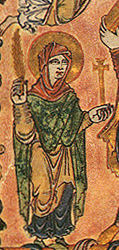 |
| Detail of the Virgin Mary |
| (wearing a headrail) 966 |
The headrail I'm talking about is a garment worn by Anglo-Saxon women. No, they didn't walk about balancing a rail on top of their heads, although that's the first image that came to my mind. A headrail is a piece of cloth that women draped losely over their head and sometimes the shoulders to cover their hair. A ribbon or circlet about the head might hold it in place. Headrails became common after the introduction of Christianity when all women, except for young girls and some slaves, wore a head covering. Headrails are the ancestor of the wimple, a more elaborate garment that might be starched, creased, and folded to create a specific shape. Some wimples require the support of wire or wicker framing.
So why the strange name? Head makes sense, but rail? The problem lies in the translation of the Old English word to modern English. The Old English word for headrail is hēafodhrægl, a combination of hēafod, meaning head, with hrægl, meaning garment. The modern English word head derives from hēafod, but hrægl fell out of usage. The rail—a horizontal bar—with which modern English speakers are familiar derives from the Old French reille, meaning a bolt or bar. Such are the hazards of mashing various languages together.
That translation took a strange turn.
ReplyDeleteNow I know what to call that covering for blinds.
Interesting post, Jeff -- etymology can be a meandering study.
ReplyDelete